过去分词作状语.
过去分词作状语知识点归纳

过去分词作状语知识点归纳过去分词作状语用法归纳一、过去分词短语作状语时,其逻辑主语通常就是句子的主语。
过去分词短语作状语一般都用逗号同其它成分隔开。
1. 作时间状语时,可转换为when或while等引导的从句,通常放在句首。
如:Seen from the top of thehill = When it is seen from the top of the hill,the school looks like a biggarden.2. 作条件状语时,可转换为once, if或unless等引导的从句,一般放在句首。
如:Given more attention =If it was given more attention, the fire could have been avoided.3. 作原因状语时,可转换为because, as或since等引导的从句,多放在句首。
如: Encouraged = As she wasencouraged by the teacher, the girl was very happy.4. 作让步状语时,可转换为though, although 或even if引导的从句,常放在句首。
如:Left = Although she wasleft alone at home, Jenny didn’t feel afraid atall.5. 作方式或伴随状语时,常可转换为并列分句,可位于句首或句末。
如:Surrounded by hisstudents, the teacher went into the lab. = The teacherwas surrounded by hisstudents and he went into the lab.6. 过去分词短语作状语时,有时为了强调,前面可带连词when, while,if, though, as if, unless等。
过去分词作状语详解
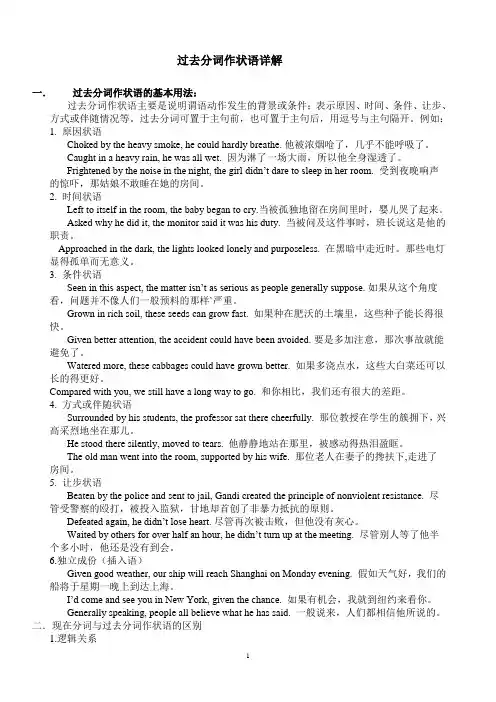
过去分词作状语详解一.过去分词作状语的基本用法:过去分词作状语主要是说明谓语动作发生的背景或条件;表示原因、时间、条件、让步、方式或伴随情况等。
过去分词可置于主句前,也可置于主句后,用逗号与主句隔开。
例如:1. 原因状语Choked by the heavy smoke, he could hardly breathe. 他被浓烟呛了,几乎不能呼吸了。
Caught in a heavy rain, he was all wet. 因为淋了一场大雨,所以他全身湿透了。
Frightened by the noise in the night, the girl didn’t dare to sleep in her room. 受到夜晚响声的惊吓,那姑娘不敢睡在她的房间。
2. 时间状语Left to itself in the room, the baby began to cry.当被孤独地留在房间里时,婴儿哭了起来。
Asked why he did it, the monitor said it was his duty. 当被问及这件事时,班长说这是他的职责。
Approached in the dark, the lights looked lonely and purposeless. 在黑暗中走近时。
那些电灯显得孤单而无意义。
3. 条件状语Seen in this aspect, the matter isn’t as serious as people generally suppose.如果从这个角度看,问题并不像人们一般预料的那样`严重。
Grown in rich soil, these seeds can grow fast. 如果种在肥沃的土壤里,这些种子能长得很快。
Given better attention, the accident could have been avoided. 要是多加注意,那次事故就能避免了。
过去分词作状语
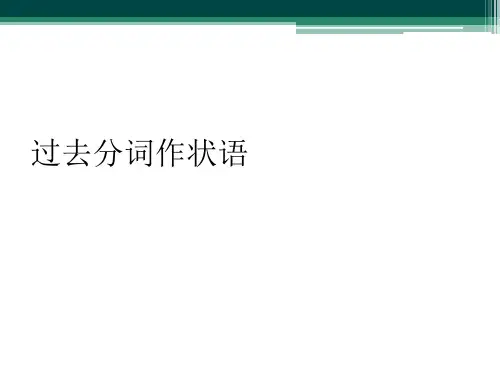
动词-ing或过去分词作状语, 其逻辑 主语应是主句主语。
2. If ___ the same treatment again, he’s sure to get well. A. giving B. give C. given D. being given
3. _____ in 1636, Harvard is one of the
A. followed C. to be followed
B. following D. being followed
3. The next morning she found the man _A__ in bed, dead.
A. lying C. lay
B. lie D. laying
4. I can hardly imagine Peter _B__ across the Atlantic Ocean in five days.
A. are bought B. bought C. been bought D. buying
( D)14. Don’t use words, expressions, or phrases ________ only to people with specific knowledge. A. being known B. having been known C. to be known D. known
高考链接
(A)1. _______ more attention, the tree
could have grown better.
A. Given B. To give
C. Giving D. Having given.
(D)2. The computer center, ________ last
过去分词(短语)作状语
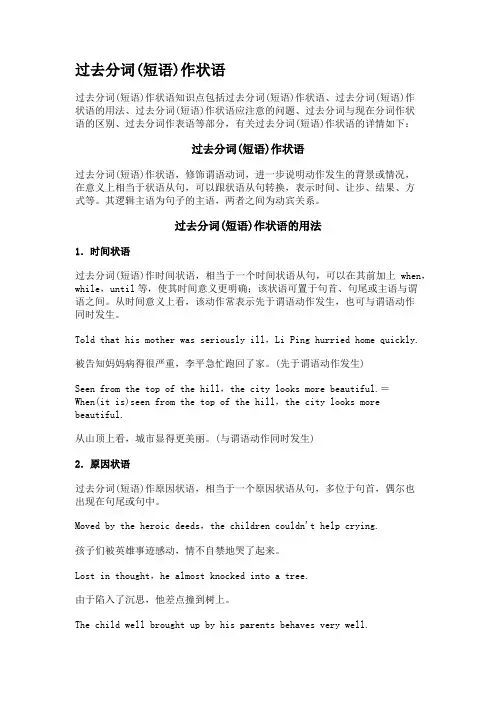
过去分词(短语)作状语过去分词(短语)作状语知识点包括过去分词(短语)作状语、过去分词(短语)作状语的用法、过去分词(短语)作状语应注意的问题、过去分词与现在分词作状语的区别、过去分词作表语等部分,有关过去分词(短语)作状语的详情如下:过去分词(短语)作状语过去分词(短语)作状语,修饰谓语动词,进一步说明动作发生的背景或情况,在意义上相当于状语从句,可以跟状语从句转换,表示时间、让步、结果、方式等。
其逻辑主语为句子的主语,两者之间为动宾关系。
过去分词(短语)作状语的用法1.时间状语过去分词(短语)作时间状语,相当于一个时间状语从句,可以在其前加上when,while,until等,使其时间意义更明确;该状语可置于句首、句尾或主语与谓语之间。
从时间意义上看,该动作常表示先于谓语动作发生,也可与谓语动作同时发生。
Told that his mother was seriously ill,Li Ping hurried home quickly.被告知妈妈病得很严重,李平急忙跑回了家。
(先于谓语动作发生)Seen from the top of the hill,the city looks more beautiful.=When(it is)seen from the top of the hill,the city looks more beautiful.从山顶上看,城市显得更美丽。
(与谓语动作同时发生)2.原因状语过去分词(短语)作原因状语,相当于一个原因状语从句,多位于句首,偶尔也出现在句尾或句中。
Moved by the heroic deeds,the children couldn't help crying.孩子们被英雄事迹感动,情不自禁地哭了起来。
Lost in thought,he almost knocked into a tree.由于陷入了沉思,他差点撞到树上。
过去分词作状语的用法(一)
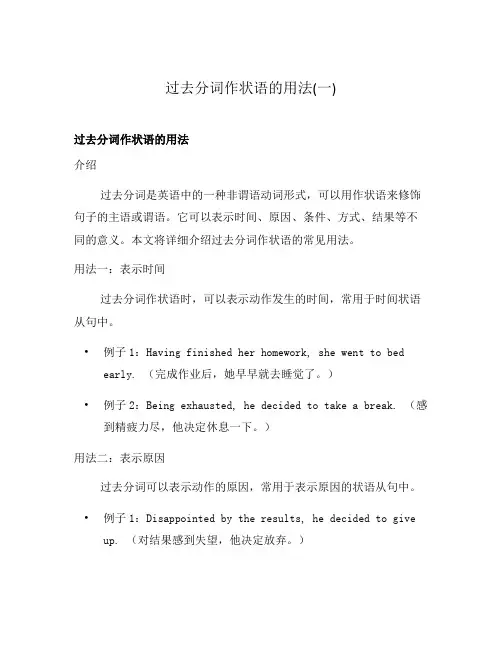
过去分词作状语的用法(一)过去分词作状语的用法介绍过去分词是英语中的一种非谓语动词形式,可以用作状语来修饰句子的主语或谓语。
它可以表示时间、原因、条件、方式、结果等不同的意义。
本文将详细介绍过去分词作状语的常见用法。
用法一:表示时间过去分词作状语时,可以表示动作发生的时间,常用于时间状语从句中。
•例子1:Having finished her homework, she went to bed early. (完成作业后,她早早就去睡觉了。
)•例子2:Being exhausted, he decided to take a break. (感到精疲力尽,他决定休息一下。
)用法二:表示原因过去分词可以表示动作的原因,常用于表示原因的状语从句中。
•例子1:Disappointed by the results, he decided to give up. (对结果感到失望,他决定放弃。
)•例子2:Feeling sick, she stayed home instead of going to work. (感到不舒服,她待在家里而不去上班。
)用法三:表示条件过去分词可以表示动作发生的条件,常用于条件状语从句中。
•例子1:Given enough time, I can finish the task. (如果给我足够的时间,我可以完成这个任务。
)•例子2:With proper training, he could become a great athlete. (经过适当的训练,他可以成为一名优秀的运动员。
)用法四:表示方式过去分词可以表示动作发生的方式,常用于方式状语从句中。
•例子1:He won the race, running as fast as he could.(他尽可能快地跑,赢得了比赛。
)•例子2:She spoke politely, not wanting to offend anyone.(她礼貌地说话,不想冒犯任何人。
过去分词作状语
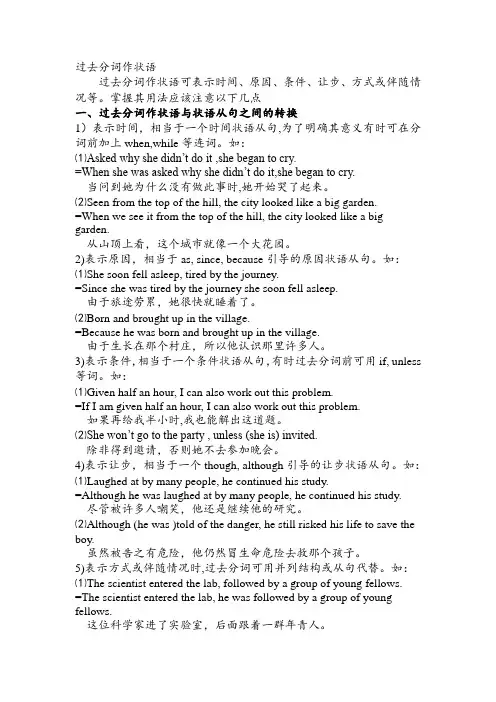
过去分词作状语过去分词作状语可表示时间、原因、条件、让步、方式或伴随情况等。
掌握其用法应该注意以下几点一、过去分词作状语与状语从句之间的转换1)表示时间,相当于一个时间状语从句,为了明确其意义有时可在分词前加上when,while等连词。
如:⑴Asked why she didn’t do it ,she began to cry.=When she was asked why she didn’t do it,she began to cry.当问到她为什么没有做此事时,她开始哭了起来。
⑵Seen from the top of the hill, the city looked like a big garden.=When we see it from the top of the hill, the city looked like a big garden.从山顶上看,这个城市就像一个大花园。
2)表示原因,相当于as, since, because引导的原因状语从句。
如:⑴She soon fell asleep, tired by the journey.=Since she was tired by the journey she soon fell asleep.由于旅途劳累,她很快就睡着了。
⑵Born and brought up in the village.=Because he was born and brought up in the village.由于生长在那个村庄,所以他认识那里许多人。
3)表示条件,相当于一个条件状语从句,有时过去分词前可用if, unless 等词。
如:⑴Given half an hour, I can also work out this problem.=If I am given half an hour, I can also work out this problem.如果再给我半小时,我也能解出这道题。
过去分词作状语的用法归纳
过去分词作状语一.过去分词作状语的基本用法:过去分词作状语主要是说明谓语动作发生的背景或条件;表示原因、时间、条件、让步、方式或伴随情况等。
过去分词可置于主句前,也可置于主句后,用逗号与主句隔开。
1. 原因状语Choked by the heavy smoke, he could hardly breathe. 他被浓烟呛了,几乎不能呼吸了。
Caught in a heavy rain, he was all wet. 因为淋了一场大雨,所以他全身湿透了。
Frightened by the n oise in the night, the girl didn’t dare to sleep in her room. 受到夜晚响声的惊吓,那姑娘不敢睡在她的房间。
2. 时间状语Left to itself in the room, the baby began to cry.当被孤独地留在房间里时,婴儿哭了起来。
Asked why he did it, the monitor said it was his duty. 当被问及这件事时,班长说这是他的职责。
Approached in the dark, the lights looked lonely and purposeless. 在黑暗中走近时。
那些电灯显得孤单而无意义。
3. 条件状语Seen in this aspect, the matter isn’t as serious as people generally suppose. 如果从这个角度看,问题并不像人们一般预料的那样`严重。
Grown in rich soil, these seeds can grow fast. 如果种在肥沃的土壤里,这些种子能长得很快。
Given better attention, the accident could have been avoided. 要是多加注意,那次事故就能避免了。
过去分词作状语
一、过去分词
过去分词有两大特点:一是表被动的概念;二是表动作已完成。
过去分词在句中可用作定语、表语、宾语补足语或状语等成分。
二、过去分词作状语的用法
1.过去分词作状语,其逻辑主语通常就是句子的主语,且与主语之间构成“被动关系”。
过去分词短语作条件、原因、以及时间状语时,通常放在句首;作伴随、结果状语时通常放在句末。
作方式状语时,一般放在句末,有时放在句首。
作让步状语通常放在句首,有时放在句末。
2. 过去分词所表示的动作发生在谓语动词之前,或表示一种状态。
与谓语动作同时发生或存在。
过去分词或过去分词短语常用于以下几种状语:
1
2。
过去分词作状语的用法
—No, it was __A______. A. very boring B. very bored
C. much boring
D. much bored
7. Written in great haste(匆忙), __D______.
A. Jim made a lot of mistakes in the report
D. being considered
13. Your idea surprised me, it is a(n) ___C_____.
A. idea surprised
B. surprised idea
C. surprising idea
D. idea surprising
14. Mrs White showed her students some old maps _C______from the library.
A.to borrow borrowed
B.to be
C.borrowed
D.Borrowing
Homework
1.Do the exercises on page 76( 优化 设计)
2.Do the exercises on page 33 in your textbook.
3.表示条件
动词-ed形式作状语表示条件,相当于一个条件状语从句。
eg: If water is heated,water changes into steam →____H_e_a_t_e_d___, water changes into steam.
加热,水就能变成蒸汽。
If he was given more time,he would be able to do better.
过去分词作状语例句
过去分词作状语例句过去分词作状语是英语中的一种语法现象,用来修饰动词,形容词,或者整个句子。
它可以表示原因、时间、条件、方式、结果等。
下面我们来看一些过去分词作状语的例句。
1. Exhausted from the long day's work, she went straightto bed.(在长时间的工作之后筋疲力尽,她直接去睡觉了)2. Surprised by the sudden news, he couldn't believe what he was hearing.(因为突如其来的消息而感到惊讶,他简直不敢相信自己的耳朵)3. Having finished their homework, the children went outto play.(完成了作业之后,孩子们就出去玩了)4. Disappointed by the result, she decided to work harder next time.(因为结果让她失望,她决定下次努力一点)5. Having been invited to the party, he decided to go and have some fun.(被邀请去参加聚会,他决定去玩玩)这些例句中,过去分词作状语修饰了主语动作的原因、时间、条件、方式或结果,丰富了句子的信息,使句子更加具体和生动。
过去分词作状语的用法灵活多样,可以用于不同的句子结构中,下面我们将分别介绍一些常见的句子结构。
1.过去分词作时间状语过去分词作时间状语时,常常表示主语动作发生的时间点或者时间段。
例如:- Having finished her work, she went home.(完成工作之后,她回家了)- Exhausted from the long day's work, she went straight to bed.(在长时间的工作之后筋疲力尽,她直接去睡觉了)2.过去分词作原因状语过去分词作原因状语时,常常表示主语动作发生的原因。
- 1、下载文档前请自行甄别文档内容的完整性,平台不提供额外的编辑、内容补充、找答案等附加服务。
- 2、"仅部分预览"的文档,不可在线预览部分如存在完整性等问题,可反馈申请退款(可完整预览的文档不适用该条件!)。
- 3、如文档侵犯您的权益,请联系客服反馈,我们会尽快为您处理(人工客服工作时间:9:00-18:30)。
非谓语动词:过去分词过去分词(短语)作状语过去分词表示完成或被动,作状语时,表示动作发生的背景或者情况,在意义上相当于一个状语从句,其省略的主语(逻辑主语)是主句的主语,且与主语之间存在被动关系。
过去分词作状语可以表示时间、条件、方式、原因、让步等。
过去分词的否定式是将not放在其前面。
一、过去分词作状语时的具体用法:1)过去分词作时间状语时,相当于一个时间状语从句。
有时过去分词前可加连词when或while来强调时间概念.例:1. Asked (When he was asked) what had happened, his face turned red.当他被问及发生了什么的时候,他的脸红了。
2. When heated (When it is heated), water changes into steam. 当加热时,水变成水蒸气。
3.Told that his mother was ill(When he was told that his mother was illl), Li Lei hurried home quickly. 李蕾得知母亲生病了时,马上赶回了家。
4. Seen from the moon(When it is seen from the moon) , the earth looks green. 从月亮上看时,地球是绿色。
2)过去分词作原因状语时,相当于一个由as, since, because等词引导的原因状语从句。
例:1. Deeply (Because they were) moved by the movie, the children began to cry.由于被电影深深地感动,孩子们哭了起来。
2. Frightened (Because she was frightened) by the horror movie, the girl didn't dare to sleepalone. 因为被惊悚电影吓坏了,这个女孩不敢单独睡觉。
3. Caught in a heavy rain (Because he was caught in a...), he was all wet.4. Satisfied with what he did (Because the teacher was satisfied with...), the teacherpraised him in class. 由于老师对他所做的事情很满意,于是在班上表扬了他。
3)过去分词作条件状语时,通常放在句子的前面,相当于if, unless等引导的条件状语从句。
例:1. Compared with you (If we are compared) , we still have a long way to go.和你们比起来,我们还有很长的一段路要走。
2. Grown (If these seeds are grown) in rich soil, these seeds can grow fast.如果种在肥沃的土壤里,这些种子能长得很快。
3. Given more time (If we were given more time), we would be able to do the work muchbetter.4. Given a few minutes (If I am given a few minutes), I’ll finish it. 再给几分钟的时间,我就会完成了4)过去分词作让步状语时,相当于一个以though / although引导的让步状语从句,这类分词或分词短语一般放在句子前面。
例:1. Left (Although he was left) at home, John didn't feel afraid at all.虽然John被单独留在房间里, 他一点都不害怕。
2. Invited by him (Though I was invited by them) , I won’t take part in the party.即使被邀请,我也不会参加聚会的。
3. Explained a hundred times (Although he was explained...) , he still can’t understand it. 即使给他解释一百篇,她还是不会明白。
4.Trained ten hours a day (Though he was trained...), he will still be a fool. 即使每天训练十个小时,他也还会是个傻瓜。
5)过去分词作状语表方式或伴随状语时不用状语从句替换,但可以改写成并列句。
例:1.She walked out of the house, (and she was) followed by her little daughter.她走出房子,后面跟着她小女儿。
2. (She was) Dressed in white, (and) she looked really pretty.穿着白衣服,她看起来确实很美。
3.She sat by the window, (and she was ) lost in thought.二、过去分词与现在分词作状语的区别:1)过去分词表完成、被动,与主句的主语之间是被动关系;现在分词表进行、主动,与主句的主语之间是主动关系。
试比较:Following the old man, we went upstairs. 跟着那个老人, 我们上了楼。
= We followed the old man, and we went upstairs.Followed by the old man, we went upstairs. 我们上了楼, 后面跟着那个老人。
= We were followed by the old man, and we went upstairs.Seen from the top, the stadium looks like a bird nest. 从上面看,体育场好像一个鸟巢。
Seeing from space, the astronaut can not discover the Great Wall. 从太空看,宇航员看不到长城。
2)若分词主语与句中主语不一致,则可以用其他方法来修正。
①用with的复合结构等.②改为相应的状语从句来表达。
③给分词添加自己的主语,构成独立主格结构④改变语态。
例如:完成作业后,孩子们出去踢足球了。
Finished their homework, the children went out to play football. (×)Their homework finished, the children went out to play football. (独立主格)Having finished their homework, the children went out to play football.(现在分词完成形式)With their homework finished(表时间), the children went out to play football. (with的复合结构) After finishing their homework, the children went out to play football. (介词+动名词)例如:当他过马路时,一辆车撞到了他。
误:Crossing the road, a car knocked him down.误:Crossed the road, he was knocked down by a car.正:Crossing the road, he was knocked down by a car. 过马路时他被车撞倒了。
正:When he was crossing the road, a car knocked him down. 他过马路时车子把他撞倒了。
※注意:分词的独立主格结构的由来解决状语分词的逻辑主语与句子主语不一致的问题,也可在分词前加一个名词或代词,使之成为分词的逻辑主语。
由于加在分词前的名词或代词要用主格形式,例:He crossing the road, a car knocked him down.The job finished, we went home. 工作结束后我们就回家了。
The weather being fine, we went swimming. 天气很好,我们就去游泳了。
He being absent, nothing couldn’t be done. 由于他缺席,什么事也干不成。
误:Barking madly,I led the dog out.正:The dog barking madly, I led it out.正:Barking madly,the dog was let out by me.正:Becuase the dog was barkling madly, I led it out.正:With the dog barking madly, I led it out.三、有些过去分词因源于系表结构,已经被形容词化。
故作状语时不表被动而表主动,表示人的状态。
get lost; be lost in(沉溺于);be seated; be compared withbe dressed in; be born; be tired of (厌烦); be tired from be worried about(表状态)be interested in; be moved by; be disappointed at; be surprised at四、选择现在分词还是过去分词,关键看主句的主语。
如分词的动作是主句的主语发出,分词就选用现在分词,反之就用过去分词。
Used for a long time, the book looks old. Using the book, I find it useful.Looking at her, he jumped with joy. Looked at by her, he jumped with joy.五、正如第四点所说,不论是动词不定式作状语、-ing分词做状语,还是动词的过去分词作状语,其逻辑主语必须是句子的主语。
